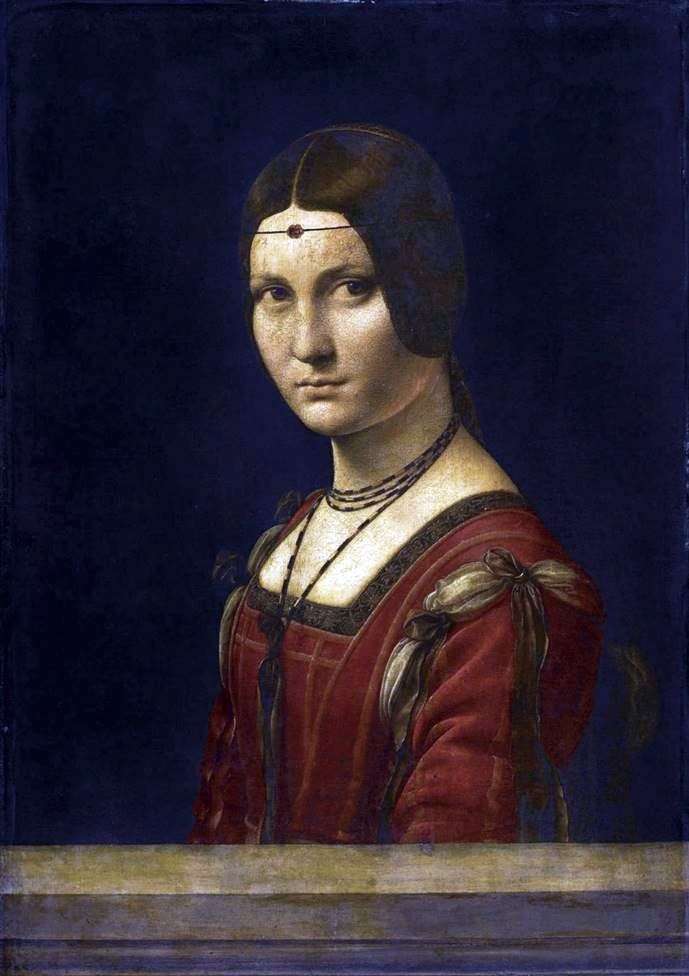
The painting by the artist Leonardo da Vinci “The Portrait of a Young Woman” also has another name “Beautiful Ferronera”. The painting was started by Leonardo da Vinci in 1990 and according to some testimonies lasted several years with interruptions. The size of the picture is 63 x 45 cm, wood, oil. Finished the picture, apparently, one of his students, the picture is sometimes called “Portrait of the Unknown”, emphasizing the unresolved issue of the identity of the depicted young woman, but much more often the painting is called “Beautiful Ferronera.”
The thought of the work of the pupil of the studio of Leonardo, the researchers of the work of the great master, induces negligence in the performance of the painting, which they noted, although this can be explained by following the traditions of Milan court painting, which required to depict the model in an unnatural position and pay more attention to details of clothing and ornaments than to the person portrayed. In the 19th century, this painting “The Beautiful Ferronera” was very popular and was often copied by many artists.
According to the most common version, the painting “Beautiful Ferronera” is a portrait of Lucretia Crivelli, mistress of the Duke of Milan, Lodovico Sforza, patron of Leonardo da Vinci. Prior to Lucrezia Crivelli, the heart of the Duke was captured by Cecilia Gallerani, who at the age of seventeen was also portrayed by Leonardo in the painting “The Lady with Ermine”. Previously it was believed that these portraits of the great artist depicted the same woman, because in the upper left corner of the picture “The Lady with Ermine” with serious grammatical errors it is written… “LA BELE FERIONIERE / LEONARD D’AWINCI”. It is believed that this inscription was misunderstood in the picture when it was restored shortly after it was acquired in 1798 and transported to Poland by Adam Jerzy Czartoryski, the future Minister of Foreign Affairs of the Russian Empire.
Distinctive features of Leonardo da Vinci’s portrait painting style are not only chiaroscuro and soft dark halftones, but also the special beauty of the lines and the softness of the relief modeling. So, in his magnificent drawings of heads, immediately executed from nature, then marked by a great degree of artistic transformation, the line has a truly powerful expressiveness.
Not being lost in details, but not avoiding them, it exhaustively and at the same time expresses the very essence of nature without the slightest schematism. The Leonardo da Vinci line is not only a contouring outline, it also possesses certain spatial stereoscopic qualities, creating a real sense of volume, living plasticity, which is enhanced by Leonardo’s characteristic oblique shading. And most importantly, the actual study element recedes in these drawings before overwhelming their poetic feelings. Such a fusion of figurative brightness and great artistic generalization is also characteristic of the portrait drawings of Leonardo da Vinci.
 Hermosa Ferronera – Leonardo Da Vinci
Hermosa Ferronera – Leonardo Da Vinci Portrait of Beatrice d’Este by Leonardo da Vinci
Portrait of Beatrice d’Este by Leonardo da Vinci Bacchus by Leonardo Da Vinci
Bacchus by Leonardo Da Vinci Self Portrait by Leonardo Da Vinci
Self Portrait by Leonardo Da Vinci Saint Jerome by Leonardo Da Vinci
Saint Jerome by Leonardo Da Vinci Madonna with spinning wheel by Leonardo Da Vinci
Madonna with spinning wheel by Leonardo Da Vinci Anghiarian battle by Leonardo da Vinci
Anghiarian battle by Leonardo da Vinci Self-portrait by Leonardo Da Vinci
Self-portrait by Leonardo Da Vinci